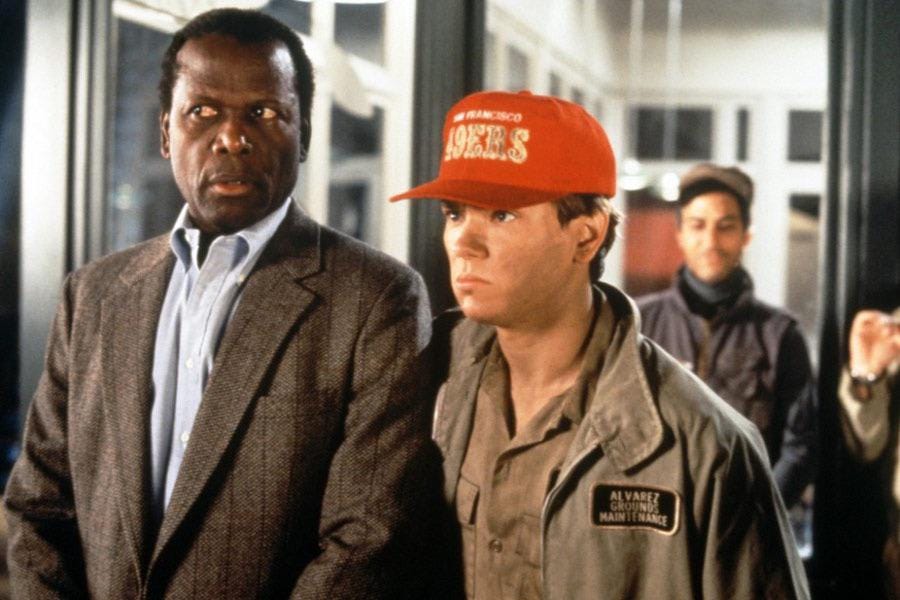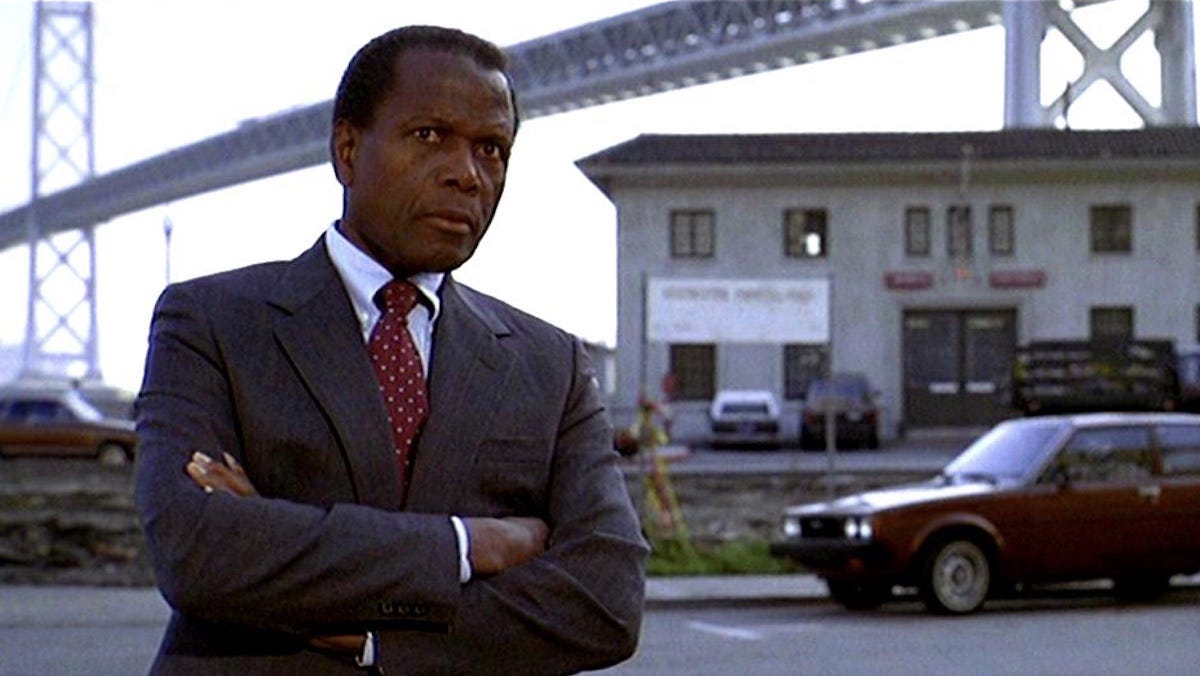
"You guys'll be chalk outlines without me."
Sidney Poitier, and my favorite movie of all time.
“There isn’t a government on this planet that wouldn’t kill us all for that thing.”
When Sidney Poitier passed away late last week at the age of 94, well-deserved accolades poured in for the actor’s decorated career. Poitier broke barriers in 1958 with an Academy Award nomination for The Defiant Ones, and followed that with an Oscar win in 1963 for Lillies of the Field—both firsts for an African-American male actor. In 1967, he starred in a trio of classics—To Sir With Love, Guess Who’s Coming To Dinner, and In The Heat of the Night—that earned him both commercial success and critical acclaim. He became known for playing serious, stern and stoic characters in socially-conscious works over a career that spanned more than five decades.
He also plays a key role in what just might be my favorite movie of all time, a modest, mid-budget suspense-comedy-heist film with a star-studded cast, a clever, twist-filled plot, and a surprisingly timeless theme: 1992’s Sneakers.
The first theatrical trailer for the film is hilariously off-tone if you’ve seen the movie1, portraying it somehow both as a madcap romp and an action-packed thrill ride; shades of later films like the 2001 Ocean’s Eleven or The Italian Job2. While Sneakers is indeed quite funny when it wants to be and has a few thrilling action sequences, the trailer is a gross misrepresentation, one that makes it obvious the studio’s marketers didn’t quite know what to make of it.
Of course, that doesn’t really matter when you’ve got a cast like this.
Sneakers features a five-man heist crew made up of Poitier, Robert Redford, Dan Aykroyd, David Strathairn and River Phoenix; other key roles are played by Mary McDonnell, Ben Kingsley and James Earl Jones, and a host of veteran character actors—George Hearn, Stephen Tobolowsky, Timothy Busfield, Donal Logue—round things out. If that sounds like a lot of big names, it is: this little caper film has four Academy Award winners and three additional Oscar nominees in its principal cast. I was initially tempted to refer to it as the “1927 Yankees” or “2017 Golden State Warriors” of movie casts, but that comparison’s not quite right—those teams won championships and are widely recognized as all-time greats. It’s more like the 1995 Cleveland Indians, a team that ultimately didn’t earn a place in any record books, but had two of the greatest hitters of all time batting 6th and 7th.3
It had a lot to work with, is what I’m saying, and either because of or in spite of the confused marketing, I saw it in theaters in 1992, at the age of ten4. I loved it.
We’re introduced to the crew almost immediately—a motley assortment of characters with questionable pasts working as what we’d likely call “security consultants” today, but described incredulously by one character in the film as being hired by companies to “break into their places... to make sure no one can break into their places?”
There’s Martin Bishop (Redford), the face man of the crew. Mother (Aykroyd) is an ex-con, a conspiracy theorist5 who can’t stop talking about cattle mutilations. The resident technical expert is Whistler (Strathairn), a blind man with remarkable auditory skills. River Phoenix plays a teenage delinquent folded into the crew after being caught (by them) hacking into his high school’s computers.
Grounding it all is Poitier, the elder statesmen of the group, an ex-CIA agent with a similar steely, steady demeanor as many of Poitier’s more famous roles. Unlike some of those roles, though, Poitier gets the chance to have fun here, whether it’s as the straight man for Aykroyd’s ridiculous musings, or as a put-upon family man who just wants to relax and take his wife on a nice European vacation. His role is essential both in the crew and for the viewers; as the intelligence expert of the group, he’s the one who can tell when they’re truly in danger, and it takes an actor with Poitier’s gravitas to sell that danger to us.
That danger arrives in the form of a new job they’re given little choice but to take.
Bishop is approached by two NSA agents who’ve uncovered his secret past as a 1960s student radical and early computer hacker. He narrowly escaped a raid from federal agents decades ago, one that put his best friend and accomplice Cosmo in jail, where he later died. If they refuse the job—an off-the-books heist of a genius mathematician’s code-breaking “black box”, the feds will take Bishop in, and he’ll spend the rest of his life in jail. If they take it and succeed, his name will be cleared and the team will profit handsomely.
I won’t reveal anything beyond this point, but what unfolds is both a fairly standard caper movie—it relies on familiar tropes, as was noted by some critics at the time—and something deeper and far more lasting.
Sneakers landed at an unusual time for spy thrillers, just after the end of the Cold War; this itself is remarked upon within the film, as one of Martin’s contacts is a former Russian agent now working, as he bemusedly notes, as a “cultural attache”. There’s little end-of-history optimism on display here, though, but rather a deep sense of both foreboding and regret, one reinforced by James Horner’s score—playful at times, but underpinned by a mournful saxophone note played by Branford Marsalis.
It would be quite reasonable to expect a technological thriller from thirty years ago to seem dated, but that’s not the case here. The physical technology on display is clearly of its time—brick-like carphones, pixelated CRT monitors with rudimentary graphics. The way the characters interact with that technology is anything but dated, though; it’s excited, but also cautious, fearful, even paranoid. There’s a sense given—one that resonates even more in 2022 than it might have in 2012 or 2002—that technological advance won’t be our savior, but just another one of the future’s broken promises.
Redford’s Bishop is a failed revolutionary, one who saw his lofty hippie ideals earn him little more than a life on the run. For his part, Poitier—three decades removed from those game-changing roles as a Black man standing tall in a racist world—still faces casual bigotry in one scene6. There’s a satisfying emotional payoff to the moment, but the inclusion of it at all is just another indication of the filmmakers’ mixed feelings about the brighter future so many were speaking of at the time.
They’re not nihilistic—Sneakers is, in spite of this, a deeply fun movie—but it’s tinged with the knowledge of how easily big promises can turn into deferred dreams.
“Don’t you know the places we could go with this?”, one character implores Bishop in a pivotal scene late in the movie.
“I do,” Bishop responds matter-of-factly. “There’s no one there.”
—Scott Hines (@actioncookbook)
If you haven’t, watch the movie first, then come back to the trailer.
Both of which, I should be careful to note, I unabashedly love.
You know those Twitter prompts that are like “what is a subject you could give a 30-minute speech on with no preparation?” My two answers are Sneakers (1992) and the 1995 Cleveland Indians.
Thanks, Mom!
One can reasonably assume that much of what Aykroyd’s character says comes from things the actor actually believes.
There’s also a small moment very early in the film that sailed right over my head as a young viewer; in preparation for a bank robbery, Phoenix’s earnest teenage character obscures his face with shoe polish. When Poitier’s character sees this obliviously-unintentional blackface, he lingers over it for an extra beat before moving on, a perfectly-executed unspoken joke.











Setec Astronomy. My voice is my passport. I love this movie.
I can't believe I'm the first to post this - Slate did a whole celebration for Sneakers' 20th anniversary with a series of articles on various aspects of it: https://slate.com/culture/2012/09/sneakers-20th-anniversary-how-the-robert-redford-caper-inspired-a-generation-of-fervent-fans.html